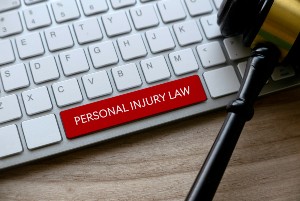A victim bringing a legal claim against a party who injured them must prove several elements integral to a personal injury case. They must prove that the accused party had a duty not to hurt them and violated that duty. They must also prove they suffered an injury and that injury directly resulted from the accused’s actions.
They must also meet the burden of proof standard. The burden of proof “describes the standard that a party seeking to prove a fact in court must satisfy to have that fact legally established.”
But what is the burden of proof in a personal injury case? Certainly, in countless movies and television shows, you may have heard that legal cases must be proven “beyond a reasonable doubt.” While that is a standard in some cases, the burden changes for different types of cases. A personal injury attorney understands how to handle the burden of proof and effectively present the victim’s case to the appropriate parties.
In Personal Injury Cases, the Burden of Proof Is “Preponderance of the Evidence”
Personal injury cases, where an entity has injured or harmed you, have a different burden of proof than a criminal case, in which someone has committed a crime such as homicide or robbery.
For a personal injury case, the burden of proof is preponderance of the evidence. That means a judge and jury must feel reasonably assured that the facts are what the plaintiff (injured person) says they are—more so than any defense argument. (The defense is the party accused of negligence.)
For a criminal injury case, on the other hand, the burden of proof is what you often hear on television: beyond a reasonable doubt. If someone is accused of homicide, the prosecution must prove to the court beyond a reasonable doubt that they are guilty. If any reasonable doubt remains, it’s grounds for acquittal.
A personal injury case takes place under civil law and in civil courts. The civil law system is quite different from the criminal law and criminal court system; that’s one reason the burden of proof differs.
In a personal injury case, someone has injured or harmed you, but they have not necessarily committed a crime. Let’s say you slipped and fell on spilled liquid in a Phoenix grocery store. The property owner may have committed negligence. Negligence refers to a failure of the store owner to act within their duty of care.
A grocery store owner’s duty of care includes making sure that the property open to the public is always safe. If it becomes unsafe, they have a duty to inform the public and make the dangerous area off-limits. That’s why stores and other retail establishments often place warning cones or tape around potentially unsafe areas, such as where someone has spilled something. They also have a duty to remedy the situation as quickly as possible, such as mopping.
If they fail to do any of these things, they may have acted negligently. If you slip and injure yourself due to the spilled liquid, the owner could be deemed negligent and liable, or financially responsible, for your injuries. But they have not necessarily committed a crime.
In some personal injury cases, a crime may have occurred as well. Let’s say a car improperly passes another on a two-line highway, and you are struck head-on as a result. The driver is charged with driving under the influence (DUI) of alcohol, a crime.
But if you suffered injuries in the accident, and want to bring a case to civil court, the negligence standard and personal injury burden of proof apply. For your purposes, the more important issue is showing the driver’s negligence. All drivers owe a duty of care to the public or driving safely and obeying the law. They breached their duty when they drove unsafely – under the influence. If the driver is convicted of a crime, you can use that to help show negligence in your case. But you can seek and recover compensation under civil law even if a negligent driver is not charged or convicted with a crime.
Other differences between civil and criminal law include who brings the case and the remedy sought. The injured party must set the case in motion in personal injury cases. In criminal cases, the police and district attorney’s office files the case in response to the possibility of a crime.
In personal injury cases, the remedy is damage compensation. The negligent party (or their insurance company) offers financial compensation for the harm you suffered. In criminal cases, the remedy is punishment, which can consist of fines, prison terms, and other penalties specified in criminal law.
The Most Common Personal Injury Cases
In Arizona, the most common personal injury cases stem from:
- Car accidents
- Truck accidents
- Motorcycle accidents
- Bicycle accidents
- Slip and fall accidents
- Premises liability (accidents on public or private property)
- DUI accidents
How Do I Meet the Burden of Proof in a Personal Injury Case?
Injured victims can meet the burden of proof in personal injury cases by presenting a preponderance of evidence to an insurance adjuster or a civil court judge and jury.
Again, the evidence must prove that you suffered injuries or other harm in the accident, that the accident was the direct cause of your injuries, and that the liable party’s action was responsible for the accident. The other party can be either a person, such as a negligent driver, or an organization, such as a property management firm that doesn’t maintain property safety.
Common documentation used to support personal injury cases includes:
- Police reports—If you are in a vehicle accident of any type, get a copy of the police report. In Arizona, if you are in an accident, you should notify law enforcement promptly, according to the Arizona Department of Transportation (ADOT). Law enforcement will produce a police report by talking to all drivers, reviewing the scene, indicating key facts, such as location and time of date, and talking to eyewitnesses if available. You should remain on the scene to receive a copy of the police report. If you are too injured to do so, obtain one as soon as you are able, or your attorney can obtain a copy.
- Surveillance footage—An increasing number of places are subject to surveillance cameras. Their footage can constitute an important piece of evidence verifying what occurred.
- Pictures or videos of the accident scene—If you are in any accident and carry a smartphone, it’s helpful to take pictures or record videos of the scene. The footage should indicate what occurred (such as skid marks from speeding and damage to street signs, for example) and the damage to vehicles and surrounding areas. It’s wise to take pictures or videos of your injuries as soon as possible after any accident as well. Your goal is to collect probable evidence of the accident’s who, what, where, why, and how.
- Medical records—Medical records can prove that you suffered injury through emergency transport and treatment, diagnostic tests, and doctor and other medical provider notes. The diagnosis, treatment plan, and prognosis are all highly important pieces of evidence. Keep all medical records and records of medical visits.
- Eyewitness information—Eyewitness information can attest to what happened and who or what caused it.
- Investigations and forensic analysis—Sometimes, you may not know who or what caused an accident, especially if you were seriously injured. Lawyer’s offices often work with professionals tasked with obtaining proof and evidence, such as investigators (who can gather footage and talk to potential eyewitnesses) and forensic analysts (who can recreate what caused an accident).
- Your notes—While your notes about an incident generally aren’t accepted as proof positive without corroborating evidence, it’s prudent to take notes about an accident as soon as possible. Include what happened, the effect on you, and why you think it occurred. Memories fade, and if your account of what occurred becomes inconsistent over time, an opposing lawyer or insurance company can use those inconsistencies to imply you are not truthful about what happened.
Do I Need All This Evidence? Isn’t It Obvious I’m Injured?

As a result, insurance adjusters may use an entire arsenal of potential strategies against you. They may, for example, have evidence that you are injured. But they may dispute the causes of your injuries! They may say your head injuries resulted from falling from the bleachers beside a tennis court, not in a truck accident. If they can prove your head injury wasn’t caused by the truck accident, they don’t have to pay your claim.
They may try to use the “another source caused your injuries” strategy if you didn’t receive or seek medical attention after an accident. For that reason, it’s always prudent to go to an emergency room or your own physician for a check-up as soon as possible after an accident. The insurer can use waiting to argue you weren’t injured.
Insurance companies can also argue that your injuries or other harm aren’t as extensive as you say. They do this, so the claim amount is lower. Be sure to keep all medical records and dates of medical visits to counter this potential allegation. If your injuries affected your ability to work and earn a living, keep records of that as well.
If your insurance company refuses to settle fairly, you can bring a personal injury lawsuit against them in civil court. Judges and juries are often more receptive to the burden of proof than insurance companies. Bringing a personal injury lawsuit is always a possible course of action as well.
What Damage Compensation Can I Receive?
In any personal injury case, the injured can seek the following damage compensation.
- Medical bills, both already incurred and future for emergency transport and treatment, hospitalization, surgery, doctor’s office visits, diagnostic tests, physical therapy, prescription medication, and more
- Wages lost from work for time lost from work due to accidents, treatment, and recovery
- Lifetime value of earnings if your injuries render you unable to work
- Pain and suffering for physical, emotional, and psychological pain and suffering
- Property damage for personal property lost or damaged in an accident
How Long Do I Have to Bring a Personal Injury Case?
If you are injured, the Grand Canyon state allows two years from the date of injury to file a case. If it exceeds that time, you’ve exceeded the statute of limitations for personal injury and property damage cases, and the courts likely won’t hear your case.
However, the burden of proof is very closely bound up with this period. The more time that elapses after your injury, the more potential challenges you may encounter in finding and gathering evidence. Records may be lost, damaged, or misplaced, memories may fade, and wounds heal.
It’s a good idea to talk to a personal injury lawyer as soon as possible after you suffer an injury. That will help position you for meeting the burden of proof.
If you have any other questions, consult a personal injury attorney who can help determine what you need to meet the burden of proof for your case.


